How to choose a pillow – find the right type for better sleep and comfort
We asked experts for their advice on picking the perfect pillow

- Why do pillows matter?
- Different sleep positions
- Best pillow filling
- Different shapes and sizes
- Choosing an ethical pillow
- Pillows for chronic issues
- Menopause pillow advice
- How many pillows should you sleep with?
- FAQs
- Allergies
- Latex pillows
- How to take care of pillows
- How to dispose of pillows
- How to break in your pillows
- What is the best pillow filling?
- Does a cooling pillow help with hot flashes?
- Is it bad to sleep without a pillow?

Knowing how to choose a pillow that is supportive, comfortable, and tailored to the way you sleep is the key to restorative slumbers. We asked medical professionals, bedding experts, and sleep clinics for all the essential information that you need to know when choosing, using, and cleaning your pillow. Here's everything they had to say.
We’re all striving for the perfect night of sleep, for which investing in the best pillows, best cooling mattresses, and the softest sheets. The perfect set-up should help you to sleep better, soothing you into deep uninterrupted slumbers. However, we all have different sleep needs, so different pillows will suit some more than others. There's no 'best pillow for everyone', but there is a very specific pillow that will help you to sleep better.
I interviewed sleep researchers, medical professionals, and bedding specialists to find out how to choose a pillow like the experts. They explained everything, from the best pillows for menopausal hot flashes; to how many pillows to sleep with; and how often you should change yours. Here are all the essential details for deep sleep.
How to choose a pillow for a good night's sleep

I used to think that the people who packed their pillows in their suitcases when they went on holiday were a bit mad. After all, a pillow is a pillow, isn't it? As it turns out, a pillow is not just a pillow. It's the difference between having a tight neck or painful shoulders and a really good night's rest.
There are many different types of pillows to cater to different needs. Pillows come in all shapes, sizes, and fillings. So, choosing the right pillow for you will need some self-reflection. You need to know the position that you sleep in, whether you move much when you sleep, and what kind of shape you're after. If you're not yet sure about any of those, don't worry, we've got the experts to help.
Why does buying the right pillow matter?

According to Dr Chelsea Perry, owner of Sleep Solutions Clinic, "The type of pillow that you choose to lay your head on will determine how you sleep. Your pillow will support and position your head, setting the tone of your spinal alignment."
Tugging your head the wrong way can give you a stiff neck, back pain, and shoulder troubles. So, if that's something you chronically suffer from, the culprit is probably a less-than-perfect pillow.
Sign up for the woman&home newsletter
Sign up to our free daily email for the latest royal and entertainment news, interesting opinion, expert advice on styling and beauty trends, and no-nonsense guides to the health and wellness questions you want answered.
You don't need to spend hundreds on a pillow — although you can if you want to — just make sure that you know how to choose a pillow that will suit the way you sleep.
Dr Perry has three rules for choosing a pillow. She says, "You'll need to know about what position you sleep in, whether that's on your back, your side, your stomach, or a combination of all three." Then Dr. Perry says, "Your pillow should sit with the natural curve of your head and neck. It needs to feel comfortable to you, whether it's firm, soft, or medium, everyone will have their preferences and that's okay."
The last factor Dr Perry suggests ticking off is materials. She says that your pillow "should be breathable, easy to clean, and hypoallergenic, so they don't interfere with your natural state."
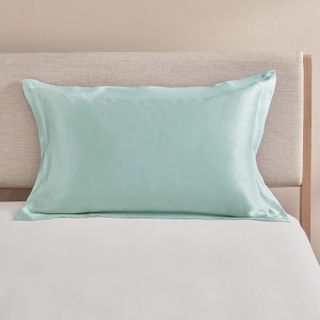
There will be other factors that you can account for in your hunt for the perfect pillow. For example, some people exclusively look for real feather pillows, but other people will prefer alternative, vegan pillows. Then there are memory foam, biodegradable, menopause-specialist cooling pillows, and more.
All of these will sit at different price points, but some of our favourites won't set you back more than £15. Considering that you'll spend a third of your life lying on it, pillows are worth spending a little more on.
What are the best pillows for different sleep positions?
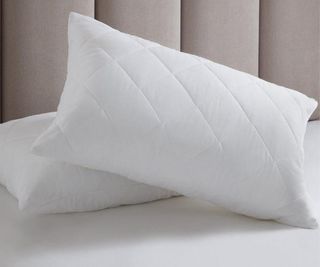
The position that you sleep in is one of the most important factors to consider when you're buying a pillow. Emma Beck, buying manager at Bensons for Beds, says "The best pillows allow your head and neck to rest in a neutral position, so your neck should not be angled differently to your spine.
Side sleepers, back sleepers, and stomach sleepers will have different demands for the amount of support and thicknesses that they need to keep your spine neutral. That's why you need to pick a pillow to match the way you sleep."
If you're a combination sleeper and wondering how to choose a pillow that will meet all your different needs, Emma recommends thinking about the one that you spend most of your time in.
Prioritise the aspects of that specialist pillow, but don't lean heavily into the features. Look for adjustable pillows too, since you can switch the firmness depending on which position you're finding yourself in most frequently. We'll go into all the details below. Right now we're considering which position is best to sleep in during hot weather.
Back Sleepers
If you're a back sleeper, you're in luck. The average pillow should give you enough support to mean that you won't wake up with aches and pains. I asked Fabio Perrotta, director of buying at Dreams, for his advice on how to choose a pillow that will give back sleepers all the support that they need. He recommends "looking for one with a medium comfort grade. This will help to provide adequate support to your head without pushing it too far forward.' If you can't see 'grade' on the pillow description, the company will likely refer to loft or thickness. A low loft pillow will be thin and a high loft pillow will be thick.
Luckily, the best pillows for back sleepers aren't limited to any specific materials. Hollowfibre, wool, memory foam, and latex are all some of the most popular options, but that's not an exhaustive list.
We've put some of our Woman & Home back sleepers out to task, sleeping on the best pillows for back sleepers (see how we test pillows). Here are their favourites:
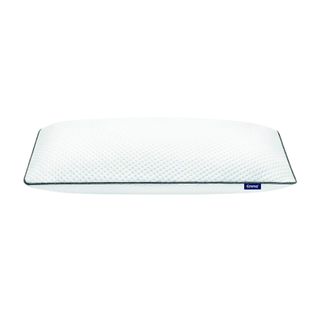
We gave this the top spot in our buying guide for the best pillows. It's breathable, comfortable, and supportive. Our back sleepers loved it, but it's also great for side sleepers.
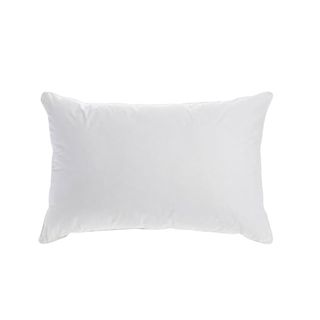
If you often wake up with hot flashes and night sweats, this luxurious pillow is perfect. It's breathable, supportive, and crafted from premium New Zealand wool.
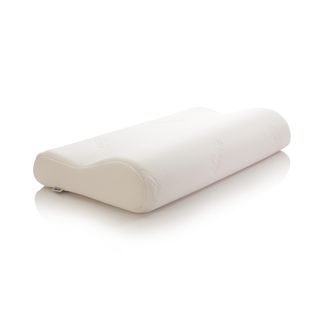
We love this pillow for its ergonomic shape that supports your neck as you sleep. It's perfect for those who suffer with neck and shoulder pain and comes with a 30-night trial.
Side Sleepers
"Side sleepers need more emphasis on head, neck, and shoulder support because it's harder to keep your spine in a neutral position," says Emma Beck, from Bensons for Beds. She recommends looking for "pillows with a medium to high loft. It should measure four to six inches or more. That additional padding gives good and will keep your spine nice and neutral. The Slumberland Deep Side Sleeper Pillow offers plush support while the iGel Side Sleeper pillow doubles down on comfort with the ideal loft."
You'll often see these pillows labelled as orthopaedic pillows. Whilst these are often the best pillows for back pain, the label doesn't mean that only people with back pain should use them.
Fabio Perecotta, from Dreams, says "They're labelled as orthopaedic because those who sleep on their sides can damage their spine's natural alignment if their head is positioned too high or low. It suits us to label them as orthopaedic, but they're really comfy and supportive for side sleepers in general."
The most popular filling for these pillows is memory foam since it'll be cushioning and sensitive to pressure points. They'll keep your neck in an optimal position. However, Fabio says, "Memory foam pillows can be warm, so if you are going through the menopause and suffering from night sweats and hot flashes, opt for a gel or cooling orthopaedic pillow, since they're designed to transfer heat away from your head."
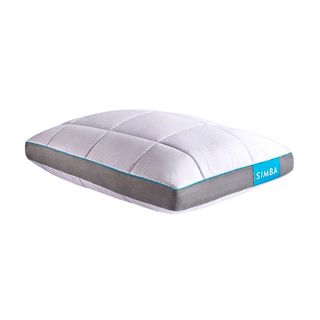
We recommend this to all sleepers because you can adjust it to suit whichever sleep style you prefer. It's the best option for side sleepers because it's soft enough to sink into, whilst offering support too.
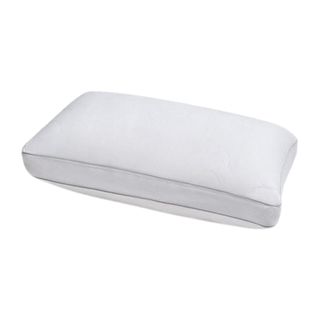
Our experts loved this pillow because it's one of the most customizable out there. You can adjust the height to suit you and then the air vents will keep it cool throughout the night. It's even hypoallergenic.
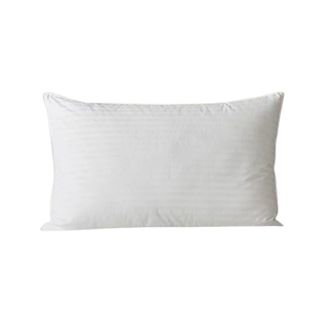
this is luxury at its finest. Even though down is historically hot, this was excellent at regulating temperature and it feels really premium too.
Stomach or Front Sleepers
Only 7% of the population sleep on their front, but if you're a stomach sleeper, you'll need to take extra special care over which pillow you choose. Emma Beck, says "The best pillow for you will be much thinner than average. There aren't very many of these on the market, but I'd recommend the Slumberland Front & Black Sleeper Pillow. This balances pressure relief and lift without pushing your head up too high."
If you're looking into the details, Fabio Perecotta, from Dreams, recommends "looking at feather pillows with a comfort grade from soft to soft-medium. This will reinforce the malleable texture of the pillow, keeping your spine perfectly neutral all through the night."
To save you from having to hunt, I've pulled together the best pillows for front sleepers. I'm actually a front sleeper myself, so I can vouch for all of these.
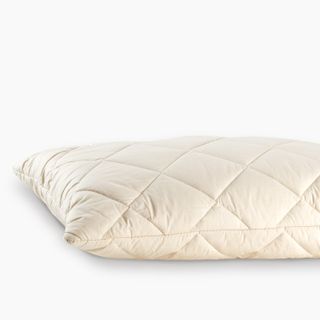
If you're a hot sleeper who is also sensitive to different materials, this is perfect. It's made with natural materials, has a removable wool filling, and it's ultra-breathable too which is why wool bedding keeps you cool.
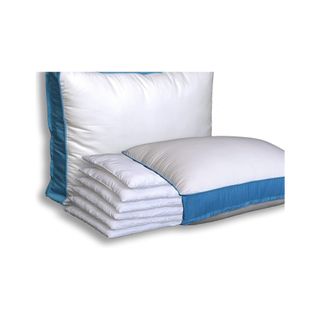
I sleep on my front, but also sometimes on my side or my back. The adjustable fill of this means that I can always get the support that my back and neck need. It's amazing.

Hot stomach sleepers will struggle to find anything as cool as this. It's infused with gel to transfer heat away from your head and it has the comfort of memory foam too.
What is the best pillow filling?
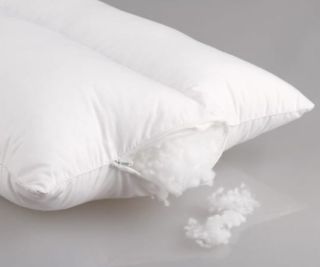
Whilst I'm all for investing in the most beautiful pillowcases out there (Piglet In Bed and The White Company, I'm looking at you), the inside of your pillow is as important as the outside. You might not even realise it, but the technology inside your pillow is so much more than simple feathers. You can choose synthetic, memory foam, gel, latex, and more, but how do you choose the right pillow filling for you?
Emma Beck explains how "pillows use the same exciting new technologies that you'll see in the latest and greatest mattresses on the market. Each offers different qualities for different sleepers, so knowing how to choose a pillow filling that will help you to sleep better is really important."
- Synthetic pillows: Microfiber or hollow-fibre, synthetic pillows are a perennially popular choice with all sleepers,' says Emma. "They tend to be cheaper, lightweight, and easy to store. You can bung them in the washing machine, fold them into whatever shape is comfortable to you, and they won't rustle around in the night." If you're not sure what kind of pillow you want and you're on a tight budget, synthetic pillows are a safe bet. This Silentnight AirMax Pillow at Argos has a synthetic fill and it's still number five in our buying guide for the best pillows. You can pick one up for under £20. The only problem is that they have a shorter life span and the filling can clump up, but that's a problem with all synthetic pillows.
- Down pillows: Down feathers come from the bellies of ducks or geese, so they have a sumptuous, cloud-like feeling. If you like sink-in pillows, you'll love these. Emma describes these as 'the last word in luxury. They're plush, soft, easy to shape, and quiet enough that they won't rustle as you move in the night.' You can pick some of the best down pillows up from places such as The White Company and Soak & Sleep. My personal favourite is The White Company's Luxury Hungarian Goose Down Pillow. If I found getting out of bed hard, this makes it ten times harder, because it's unbelievably soft. Whilst Emma thinks they're great, she cautioned that down pillows are only worth their luxury price tag if you're a specific kind of sleeper. She says "Down pillows aren't very supportive, nor are they suitable for vegans, so invest with caution."
- Feather pillows: Feather pillows are a classic, but Emma says that 'they have fallen out of fashion more recently.' People originally liked feather pillows because they're bigger and cheaper than down, whilst boasting a longer lifespan than synthetics. Even though they suit most sleep styles, they compromise in too many places. If you move a lot, you'll be kept up with the rustling sound of feathers. And, they're not suitable for vegans or allergy sufferers. Most sleep specialists will sell feather pillows. You can often find them grouped with down pillows too. Somewhere such as John Lewis has reasonably-priced feather pillows that are crafted with quality materials too.
- Memory foam pillows: Emma's eyes light up when we're talking about memory foam pillows. "They're a technological breakthrough that was created by no less than NASA themselves," she beams, "memory foam has been put through its paces up there in outer space, where no one can hear you snore." If you suffer from neck and shoulder pain, you'll likely end up with a memory foam pillow. This moulds to the shape of your head, helping with pressure relief. These pillows also won't become lumpy, because they're crafted from one single piece of foam. The only downside is that they can be expensive (and hot if you wake up with night sweats). The best memory foam pillow that we've tested is from Emma UK. It's adjustable and more breathable than all the other memory foam pillows out there.
- Gel pillows: If you like the supportive, pressure-relieving properties of memory foam, but you're a hot sleeper, gel pillows are perfect for you. These have all the same benefits as memory foam, whilst they can also distribute heat away from your body. A brilliant example is the Silentnight Geltex Support Pillow which costs just £35 at Amazon. It's cooling and has a wonderful bounce-back feeling too. Dr Chelsea Perry, from Sleep Solutions Clinic, says "Gel pillows are also hypoallergenic, durable, and suitable for various sleeping positions. You won't have to compromise on anything here."
- Latex pillows: If you like the single height and support of memory foam, you'll like the sound of latex too. Emma says "Latex provides excellent support, moulding to the head and neck. It's also cooler than latex and quiet, perfect if you're a hot and restless sleeper. Just make sure you air yours before use because these do smell chemically at first." Dunlopillo Super Comfort Pillow provides deep, gentle support that’s ideal for side sleepers, whilst the Dunlopillo Serenity Pillow provides shallow support that’s suitable for front or back sleepers. Both of these are less than £100, which is a reasonable price to pay for latex.
- Wool pillows: Jessica Hanley, founder of Piglet in Bed, says "If you’re wanting an undisturbed night’s sleep, pillows filled with British wool and merino wool make for an excellent option given the materials are thermoregulatory, transporting sweat away from the skin and keeps you at just the right temperature for a more restful slumber. Our British wool and merino wool pillow inserts are also encased in cotton and available in three differing weights, depending on what level of support you might be looking for."
There are other options out there. For example, polyester is popular for cheaper cushions, but all the experts say that it's less durable and breathable, so the benefits of saving money are really only short-term. There are also buckwheat pillows, which you can adjust the shape of, plus, they're supportive and naturally cooling. Our list could go on forever, but these will cover most people's needs. I've even summarised them in the table below, just in case you're more of a visual shopper.
| Header Cell - Column 0 | Pros | Cons |
|---|---|---|
| Synthetic | Hypoallergenic, affordable, low maintenance, lightweight | Durability, heat retention, some chemicals |
| Down | Comfortable, lightweight, breathable | Expensive, maintenance, allergens, not vegan |
| Feather | Supportive, durable, adjustable | Can be noisy, feathers are prickly, higher maintenance, allergens |
| Memory Foam | Supportive, good for pressure relief, durable | Gets hot, can smell, heavier than others |
| Gel | Cooling, supportive, good for pressure relief | Expensive, heavier than others, not as durable |
| Latex | Good support, durable, hypoallergenic | More expensive, heavier than others, can be too firm |
| Polyester | Good price, hypoallergenic, easy to maintain | Durable, gets hot, lacks support |
| Buckwheat | Supportive, breathable, natural materials | Can be noisy, heavy, can be too firm, quite high maintenance |
What are the different pillow shapes and sizes?
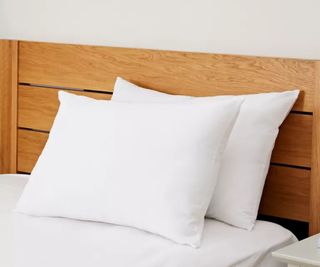
When you're researching how to choose a pillow, you'll notice that they come in all shapes and sizes. The five main ones are standard, kingsize, wedge, orthopaedic, and body.
The names of these are all pretty self-explanatory; an orthopaedic pillow is designed for your back, a body pillow is designed to be used across your whole body, and so on. Experts place more emphasis on the fill and type of pillow that you're buying, but it's worth knowing about the different shapes too.
I've made a helpful table of what you can expect from the different-shaped pillows out there...
| Header Cell - Column 0 | Standard | Kingsize | Square | Orthopaedic | Body |
|---|---|---|---|---|---|
| Dimensions (inches) | 20 x 26 | 20 x 36 | 26 x 26 | Range | 20 x 54 |
| Suitable for | Most sleepers, standard beds | Side sleepers, big beds, reading in bed | Decorative, back support when sitting | Side and back sleepers, people with sleep issues | Pegnant women, side sleepers, full body support |
| Not suitable for | People who like bigger pillows, people with specific sleep issues | Small beds, stomach sleepers | Sleeping | Stomach sleepers, those without any issues | Stomach sleepers, small beds |
Choosing an ethical pillow
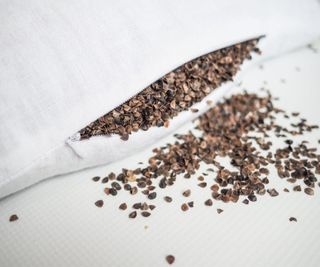
If ethical, eco-conscious credentials are at the top of your list of priorities, there are some easy ways to make sure you choose the best ethical pillow out there. Lauri Leadley, the founder & president at Valley Sleep Center, recommends 'looking for natural materials, first and foremost. You'll want pillows that are made from natural fibres such as cotton and bamboo on the exterior and then fluffy cotton or goose feathers on the inside.'
There are plenty of pillows out there that claim to be super eco-friendly, but you need to make sure that you're buying a pillow that is both sustainable and suitable for your sleep style.
Lauri says, "The way to approach these pillows is by splitting them into two categories. The first is natural, organic, or eco-friendly pillows. These are really the ones that you want. They'll likely be crafted from cotton, bamboo, buckwheat, Tencel, feathers, or wool. Make sure you look at the composition, because even if you are covering your pillows with high-quality pillowcases, the superiority of the pillow itself, counts too. You want a pillow that breathes from the inside out – it’ll help keep you cool and fluff up without much shaking or kneading."
You can cross-check the claims made by these pillows, by looking for official organisations. For example, the brand might use feathers certified by the Responsible Down Standard. People also like to look for organic, biodegradable, and B-Corp certifications to indicate that the brand is a conscious, considerate company.
In the second category are synthetic pillows crafted from memory foam, latex, and polyester. Lauri says "these are rarely eco-friendly and they'll get hot at night, so steer clear of them if you put a lot of weight on the environmental cost of your pillows. You might still be able to find some that fit the bill, but it'll take a lot of work."
Lauri also recommends 'avoiding simply Googling 'the best eco-friendly pillow', since that won't be suited to you and your sleep style. You'll end up buying a less than perfect pillow and you won't use it for very long. Then, you'll have to invest in a new pillow, which is even worse for the environment.
Can pillows help with chronic issues?
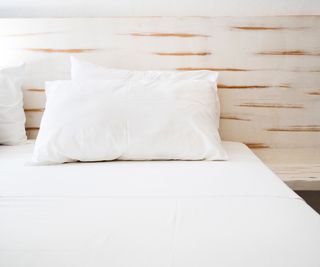
Whether you're suffering from hot flashes or sciatica, you'll be looking into every aspect of your sleep setup. Pillows can play an important role in some of your sleep issues. Whilst there are plenty of pillows that will help you deal with back and neck pain, there are alternative ways to use your pillow too. For example, some say sleeping with a pillow between your legs can help with back pain.
I asked Patrick Gunther, PlushBeds' pillow specialist, whether there are any pillows that can help to solve specific sleep problems. He enthusiastically told me that "pillows can absolutely help. Different types of pillows offer improved support and alignment, which will make you more comfortable."
If you're looking for the best pillows for neck pain, it's likely that you'll see a lot of memory foam pillows. These are a classic solution for helping with neck and back issues that flair up overnight. Patrick says "The way memory foam works is by moulding to your head and neck, so it can reduce pressure points and help you with spinal alignment."
"If you want something a little more natural, buckwheat pillows provide customisable support and excellent breathability," Patrick says he recommends these to women going through menopause or generally hot sleepers because buckwheat can offer the pressure relief of memory foam with the breathability of gel pillows.

That's not the end of what pillows have to offer. We all snore from time to time, but if you're finding that it's a persistent problem, it could be down to the pillows you use.
Dr Chelea Perry, from Sleep Solutions Clinic, says, "In my sleep clinic I focus on sleep apnea and snoring. Pillows can help reduce snoring and mild sleep apnea symptoms. Some of the pillows that help in this area do so by encouraging you to sleep on your side. These pillows often have unique shapes or features to prevent rolling onto your back. Wedge-shaped pillows, for back sleepers, can help keep your airway open by elevating the head, reducing the likelihood of the tongue and soft tissues collapsing into the throat."
For all the praise that pillows get from the experts, it's worth noting that not every chronic pain can be resolved with a pillow. Lauri Leadley, founder & president at Valley Sleep Center, says "I wish a pillow was the simple answer to all chronic pain, but you'll also need to take a look at medical history, conditions, and treatments to find what's impacting your sleep.
At our clinic, we run a polysomnography, which helps diagnose the root cause of insomnia or sleep apnea, allows us to treat accordingly, and then enhance that effort with mattress, pillows, and bedding suggestions. Also remember, all sound sleep begins with a consistent sleep hygiene and bedtime routine. It’s worth the habit."
If you find yourself seriously struggling, take a deeper look into how you sleep.
Is there a perfect pillow for menopausal women?
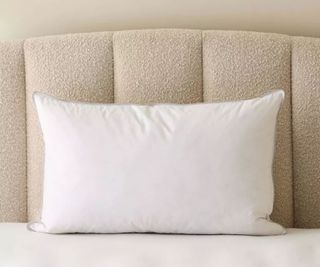
Hot, sweaty, sleepless nights, broken with hot flashes, can make you feel like you're going crazy. Investing in ways to keep your bedroom cool at night can be a great way to soothe some of your menopausal suffering. We've tried every trick in the book, from fans with bowls of ice in front of them to cooling sheets and you'll be pleased to know that some pillows will make a difference.
Jessica Hanley, Founder of Piglet In Bed, says "the menopause can wreak havoc with your sleeping patterns, which can make the night sweats even more intolerable. I recommend choosing fabrics that are super-breathable, gentle on the skin, and moisture-wicking. Pure linen or linen blends would be my go-to because the long linen fibres let air circulate, whilst taking sweat away from your skin. Plus, they'll only get softer with age."
Lauri Leadley, founder & president at Valley Sleep Centre, adds to Jessica's advice by recommending to "do all you can to naturally cool your body down before bedtime, cool showers, low thermostats, and fans are all useful tools to have around, but bedding that's made out of cotton and organic materials will be much better at keeping you cool than synthetic fabrics."
Take a look at bamboo and buckwheat pillows, especially ones that are tailored to cooling sleep.' We have some recommendations for the best cooling pillows to help with hot flashes in our dedicated buying guide. We had our hot sleepers test them out, so we could personally recommend them to you.

They're not your only options though. I asked Fabio Perrotta whether a cooling pillow will help with hot flashes and Fabio says that "cooling pillows and memory foam pillows are great options for menopausal women. These pillows are specifically designed with cooling gel, breathable structures, and phase-change materials that will help you regulate temperature throughout the night.
The Dreams Team GB Cooling Pillow Pair is popular with hot sleepers because of its natural temperature-regulating features. The cover is made from 100% pure cotton and it comes with a lyocell cooling cover, which is the kind of properties that you'll want to look for if you want the best pillow for menopause night sweats."
Fabio also recommends the TEMPUR Prima Cooling Pillow because "it's made up of billions of ultra-sensitive cells, sp the unique material responds to your shape, weight, and warmth throughout the night, meaning that you can get some serious, restful sleep."
How many pillows should you sleep with?
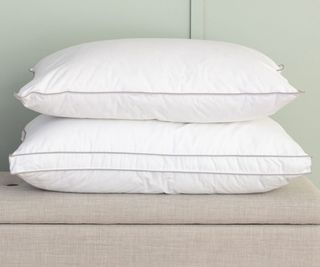
When considering how many pillows you should sleep with I always believed that two was the magic number for pillows. That's what you see plumped up on plush hotel beds, so it must be perfect, right? Wrong. Again, it's no one-size-fits-all answer. Fabio Perrotta, says "The number of pillows that you need for optimal sleep comes down to personal preference and sleeping positions."
Some people like to sleep with none, so they're completely flat on their back or belly and others like some more support, whether it's a pillow behind the lower spine or elevating their neck and head.
Dr Shelby Harris, director of sleep health at Sleepopolis, says that "one or two pillows per person usually does the trick. You'll want one for sleep and maybe another for extra support or comfort. Consider more for specific needs, like knee support or propping up your back before you settle on a specific answer."
All of the experts recommend testing different options out and seeing how you sleep. It's even worth sleeping with a pillow between your legs if you struggle to keep your pelvis and spine neutral. Or, take a picture of yourself lying with different numbers of pillows. The perfect number will be the ones that keep your spine sitting as neutrally as possible.
FAQs
Can I be allergic to my pillow?
Your pillows can be packed with allergens, so if you suspect that your pillow is triggering a reaction, it probably is. There are plenty of anti-allergy or hypoallergenic pillows (such as these from Soak&Sleep) out there on the market, which are designed for people with mild allergies that might be triggered by dust mites. These are often filled with silk or wool because dust mites and bacteria don't like these as environments.
You can buy anti-allergy feather pillows too. These are ultra clean at first, so won't trigger your allergies. However, over time, allergens might build up inside them, so make sure that you're using a pillow protector and regularly cleaning your pillow.
Are latex pillows any good?
If you haven't done much research into bedding, latex might sound like a strange thing to have in your bedding. It's good for a lot of people. Latex is naturally cooling, bouncy, and breathable. It's not often as contoured as memory foam pillows, but that suits some sleepers.
Patrick, from PlushBeds, says "Amongst the various options, solid latex and shredded latex pillows stand out to me. They can address various sleep issues because they offer a blend of support, comfort, and sensitive materials.
Solid latex pillows, made from a single piece of latex foam, offer consistent support and maintain proper spinal alignment, even if you change positions in the nighttime. They're hypoallergenic, dust mite-resistant, and naturally breathable making them great for allergy sufferers and hot sleepers."
"Shredded latex pillows are also great for hot sleepers. These are clever for many reasons," says Patrick, "primarily because the small pieces of latex adjust to different sleeping positions — back, side, or stomach. They're best known for their breathability, which helps to keep you cool."
How to take care of pillows
You must look after your pillows if you want them to last. Both from a hygiene and allergen point of view, you should wash your pillow every four months.
Jessica Hanley, founder of Piglet In Bed, says "your pillows absorb the moisture we breathe and sweat, as well as the skincare and products we use, so you ought to wash your pillows two to four times a year on low heat with a gentle cycle, but always check the pillow label before doing so. Merino wool ones might need to be left in fresh air, in the sunshine to keep them toxin-free, fresh, and clean. You should also think about changing your pillow every two years or so to maintain support and minimise bacteria growth." Dr Perry, from SleepSolutions Clinic, adds "pillows should be replaced every one to two years because, over time, pillows lose their shape and accumulate allergens, which can affect sleep quality and health.'"
Some experts say that your pillow can stretch to three years, but remember that your pillow is accumulating dirt, saliva, oils, sweat, bacteria, mould, makeup, residue, and fungi, so it's good to give them a freshen-up as often as possible - take note of how to remove yellow stains from your pillows.
How to dispose of pillows
When you're shopping for new pillows, it's important that you get rid of old ones too. Dr Chelsea Perry says "You have a few options for getting rid of old pillows. You could recycle them. Some recycling centres accept pillows. You could use old pillows for pet beds, cushioning for moving, or craft projects. If your pillow is still in good condition, it can be donated to animal shelters."
It's best to avoid landfills, especially since there are plenty of other options, but they are accepted as general waste if you have to put them in there.
How to break in your pillows
Lots of people ask how to break in their pillows as well as how long it takes to break in a pillow. Dr Chelsea Perry, says, "All you have to do is use your pillow consistently over time. As long as you use yours like you would every night, it'll adjust to your comfort level. Fluff it often, make sure to wash it too, and it should look after you in the long term."
What is the best pillow filling?
Marten Carlson, a Certified Sleep Science Coach at Mattress Clarity, says "The filling you should use depends on your personal preferences and sleeping position. Memory foam is great because it moulds to the body, and provides excellent neck support. Feather pillows offer soft comfort but less support making them a better option for stomach sleepers. Latex pillows are firm and resistant to dust mites, which is helpful for allergy sufferers. Polyester fill is versatile and inexpensive but less durable than other options."
Does a cooling pillow help with hot flashes?
I'll be straight with you. A cooling pillow isn't going to magically wave away your hot flashes in the night, nor will it cool down your room, but sleeping on one can really help you cool down quicker. If you pair it with cooling sheets and a temperature-regulating mattress, you'll find that it can really help to keep you more comfortable throughout the night.
Is it bad to sleep without a pillow?
When I asked the experts how many pillows to sleep with, they all told me that it's a matter of personal preference. If you sleep on your front, not having a pillow will be useful for keeping your spine neutral. If you sleep on your back or side, you probably will need a pillow (otherwise you'll get some neck or back pain), but front sleepers might find removing all of their pillows helpful.
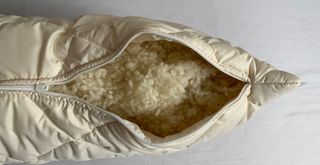
Once you've worked out how to choose a pillow, there's a whole world of pillow accessories to explore. There are some beautiful pillowcases out there that will complement the aesthetics of your bedroom as well as your sleep style. If you want a sneak peek, here are some of our favourite silk pillowcases out there.

Laura is woman&home's eCommerce editor, in charge of testing, reviewing and creating buying guides for the Homes section, so you'll usually see her testing everything from the best dehumidifiers to sizing up the latest Le Cruset pot. Previously, she was eCommerce editor at Homes & Gardens magazine, where she specialised in covering coffee and product content, looking for pieces tailored for timelessness. The secret to her heart is both simplicity and quality. She is also a qualified Master Perfumer and holds an English degree from Oxford University. Her first editorial job was as Fashion writer for The White Company.
-
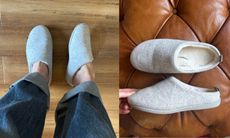 Goodbye premium prices - these M&S slippers have become my new indoor go-to
Goodbye premium prices - these M&S slippers have become my new indoor go-toFor £19.50, these are a wardrobe must-have that you'll reach for daily
By Molly Smith Published
-
 Zara Tindall and Princess Eugenie twin in maroon at Cheltenham as they show how occasionwear styling is done
Zara Tindall and Princess Eugenie twin in maroon at Cheltenham as they show how occasionwear styling is doneRoyal cousins Zara Tindall and Princess Eugenie were on the same page with their Cheltenham outfits and their approach is worth following
By Emma Shacklock Published